Junmo Kim
Comparison Reveals Commonality: Customized Image Generation through Contrastive Inversion
Aug 11, 2025Abstract:The recent demand for customized image generation raises a need for techniques that effectively extract the common concept from small sets of images. Existing methods typically rely on additional guidance, such as text prompts or spatial masks, to capture the common target concept. Unfortunately, relying on manually provided guidance can lead to incomplete separation of auxiliary features, which degrades generation quality.In this paper, we propose Contrastive Inversion, a novel approach that identifies the common concept by comparing the input images without relying on additional information. We train the target token along with the image-wise auxiliary text tokens via contrastive learning, which extracts the well-disentangled true semantics of the target. Then we apply disentangled cross-attention fine-tuning to improve concept fidelity without overfitting. Experimental results and analysis demonstrate that our method achieves a balanced, high-level performance in both concept representation and editing, outperforming existing techniques.
B4DL: A Benchmark for 4D LiDAR LLM in Spatio-Temporal Understanding
Aug 07, 2025Abstract:Understanding dynamic outdoor environments requires capturing complex object interactions and their evolution over time. LiDAR-based 4D point clouds provide precise spatial geometry and rich temporal cues, making them ideal for representing real-world scenes. However, despite their potential, 4D LiDAR remains underexplored in the context of Multimodal Large Language Models (MLLMs) due to the absence of high-quality, modality-specific annotations and the lack of MLLM architectures capable of processing its high-dimensional composition. To address these challenges, we introduce B4DL, a new benchmark specifically designed for training and evaluating MLLMs on 4D LiDAR understanding. In addition, we propose a scalable data generation pipeline and an MLLM model that, for the first time, directly processes raw 4D LiDAR by bridging it with language understanding. Combined with our dataset and benchmark, our model offers a unified solution for spatio-temporal reasoning in dynamic outdoor environments. We provide rendered 4D LiDAR videos, generated dataset, and inference outputs on diverse scenarios at: https://mmb4dl.github.io/mmb4dl/
Controllable Feature Whitening for Hyperparameter-Free Bias Mitigation
Jul 27, 2025Abstract:As the use of artificial intelligence rapidly increases, the development of trustworthy artificial intelligence has become important. However, recent studies have shown that deep neural networks are susceptible to learn spurious correlations present in datasets. To improve the reliability, we propose a simple yet effective framework called controllable feature whitening. We quantify the linear correlation between the target and bias features by the covariance matrix, and eliminate it through the whitening module. Our results systemically demonstrate that removing the linear correlations between features fed into the last linear classifier significantly mitigates the bias, while avoiding the need to model intractable higher-order dependencies. A particular advantage of the proposed method is that it does not require regularization terms or adversarial learning, which often leads to unstable optimization in practice. Furthermore, we show that two fairness criteria, demographic parity and equalized odds, can be effectively handled by whitening with the re-weighted covariance matrix. Consequently, our method controls the trade-off between the utility and fairness of algorithms by adjusting the weighting coefficient. Finally, we validate that our method outperforms existing approaches on four benchmark datasets: Corrupted CIFAR-10, Biased FFHQ, WaterBirds, and Celeb-A.
FairASR: Fair Audio Contrastive Learning for Automatic Speech Recognition
Jun 12, 2025Abstract:Large-scale ASR models have achieved remarkable gains in accuracy and robustness. However, fairness issues remain largely unaddressed despite their critical importance in real-world applications. In this work, we introduce FairASR, a system that mitigates demographic bias by learning representations that are uninformative about group membership, enabling fair generalization across demographic groups. Leveraging a multi-demographic dataset, our approach employs a gradient reversal layer to suppress demographic-discriminative features while maintaining the ability to capture generalizable speech patterns through an unsupervised contrastive loss. Experimental results show that FairASR delivers competitive overall ASR performance while significantly reducing performance disparities across different demographic groups.
PRISM: Video Dataset Condensation with Progressive Refinement and Insertion for Sparse Motion
May 28, 2025Abstract:Video dataset condensation has emerged as a critical technique for addressing the computational challenges associated with large-scale video data processing in deep learning applications. While significant progress has been made in image dataset condensation, the video domain presents unique challenges due to the complex interplay between spatial content and temporal dynamics. This paper introduces PRISM, Progressive Refinement and Insertion for Sparse Motion, for video dataset condensation, a novel approach that fundamentally reconsiders how video data should be condensed. Unlike the previous method that separates static content from dynamic motion, our method preserves the essential interdependence between these elements. Our approach progressively refines and inserts frames to fully accommodate the motion in an action while achieving better performance but less storage, considering the relation of gradients for each frame. Extensive experiments across standard video action recognition benchmarks demonstrate that PRISM outperforms existing disentangled approaches while maintaining compact representations suitable for resource-constrained environments.
DAM: Domain-Aware Module for Multi-Domain Dataset Condensation
May 28, 2025Abstract:Dataset Condensation (DC) has emerged as a promising solution to mitigate the computational and storage burdens associated with training deep learning models. However, existing DC methods largely overlook the multi-domain nature of modern datasets, which are increasingly composed of heterogeneous images spanning multiple domains. In this paper, we extend DC and introduce Multi-Domain Dataset Condensation (MDDC), which aims to condense data that generalizes across both single-domain and multi-domain settings. To this end, we propose the Domain-Aware Module (DAM), a training-time module that embeds domain-related features into each synthetic image via learnable spatial masks. As explicit domain labels are mostly unavailable in real-world datasets, we employ frequency-based pseudo-domain labeling, which leverages low-frequency amplitude statistics. DAM is only active during the condensation process, thus preserving the same images per class (IPC) with prior methods. Experiments show that DAM consistently improves in-domain, out-of-domain, and cross-architecture performance over baseline dataset condensation methods.
MedRep: Medical Concept Representation for General Electronic Health Record Foundation Models
Apr 11, 2025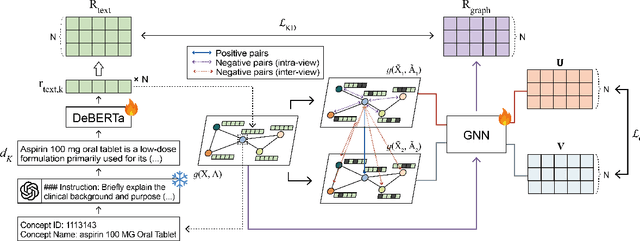
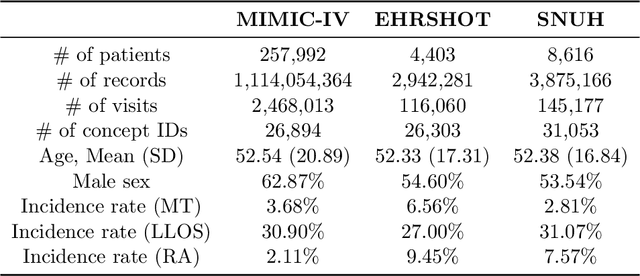
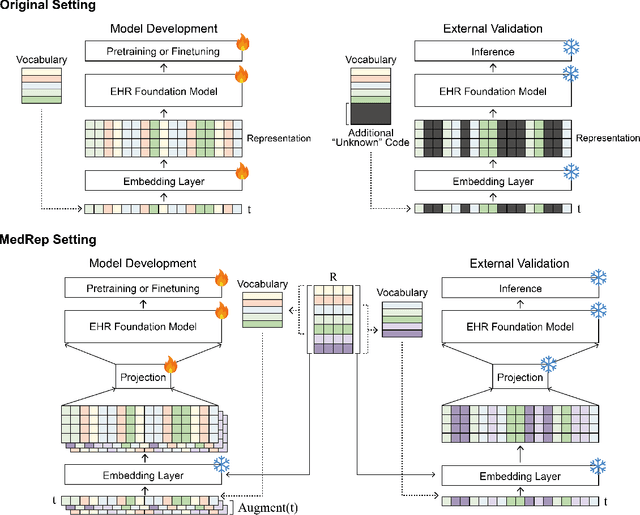

Abstract:Electronic health record (EHR) foundation models have been an area ripe for exploration with their improved performance in various medical tasks. Despite the rapid advances, there exists a fundamental limitation: Processing unseen medical codes out of the vocabulary. This problem limits the generality of EHR foundation models and the integration of models trained with different vocabularies. To deal with this problem, we propose MedRep for EHR foundation models based on the observational medical outcome partnership (OMOP) common data model (CDM), providing the integrated medical concept representations and the basic data augmentation strategy for patient trajectories. For concept representation learning, we enrich the information of each concept with a minimal definition through large language model (LLM) prompts and enhance the text-based representations through graph ontology of OMOP vocabulary. Trajectory augmentation randomly replaces selected concepts with other similar concepts that have closely related representations to let the model practice with the concepts out-of-vocabulary. Finally, we demonstrate that EHR foundation models trained with MedRep better maintain the prediction performance in external datasets. Our code implementation is publicly available at https://github.com/kicarussays/MedRep.
SFLD: Reducing the content bias for AI-generated Image Detection
Feb 24, 2025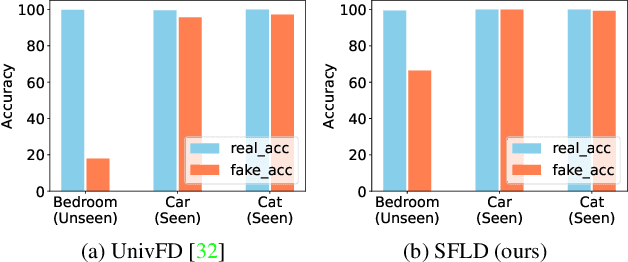

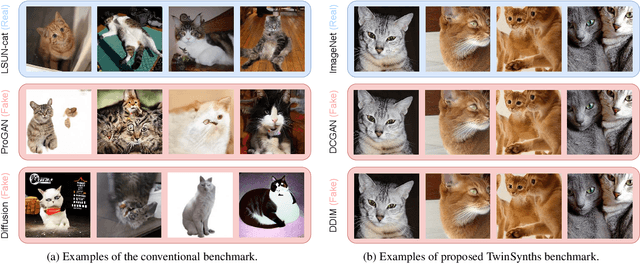

Abstract:Identifying AI-generated content is critical for the safe and ethical use of generative AI. Recent research has focused on developing detectors that generalize to unknown generators, with popular methods relying either on high-level features or low-level fingerprints. However, these methods have clear limitations: biased towards unseen content, or vulnerable to common image degradations, such as JPEG compression. To address these issues, we propose a novel approach, SFLD, which incorporates PatchShuffle to integrate high-level semantic and low-level textural information. SFLD applies PatchShuffle at multiple levels, improving robustness and generalization across various generative models. Additionally, current benchmarks face challenges such as low image quality, insufficient content preservation, and limited class diversity. In response, we introduce TwinSynths, a new benchmark generation methodology that constructs visually near-identical pairs of real and synthetic images to ensure high quality and content preservation. Our extensive experiments and analysis show that SFLD outperforms existing methods on detecting a wide variety of fake images sourced from GANs, diffusion models, and TwinSynths, demonstrating the state-of-the-art performance and generalization capabilities to novel generative models.
Efficient Dynamic Scene Editing via 4D Gaussian-based Static-Dynamic Separation
Feb 04, 2025



Abstract:Recent 4D dynamic scene editing methods require editing thousands of 2D images used for dynamic scene synthesis and updating the entire scene with additional training loops, resulting in several hours of processing to edit a single dynamic scene. Therefore, these methods are not scalable with respect to the temporal dimension of the dynamic scene (i.e., the number of timesteps). In this work, we propose an efficient dynamic scene editing method that is more scalable in terms of temporal dimension. To achieve computational efficiency, we leverage a 4D Gaussian representation that models a 4D dynamic scene by combining static 3D Gaussians with a Hexplane-based deformation field, which handles dynamic information. We then perform editing solely on the static 3D Gaussians, which is the minimal but sufficient component required for visual editing. To resolve the misalignment between the edited 3D Gaussians and the deformation field potentially resulting from the editing process, we additionally conducted a refinement stage using a score distillation mechanism. Extensive editing results demonstrate that our method is efficient, reducing editing time by more than half compared to existing methods, while achieving high editing quality that better follows user instructions.
Self-supervised Transformation Learning for Equivariant Representations
Jan 15, 2025



Abstract:Unsupervised representation learning has significantly advanced various machine learning tasks. In the computer vision domain, state-of-the-art approaches utilize transformations like random crop and color jitter to achieve invariant representations, embedding semantically the same inputs despite transformations. However, this can degrade performance in tasks requiring precise features, such as localization or flower classification. To address this, recent research incorporates equivariant representation learning, which captures transformation-sensitive information. However, current methods depend on transformation labels and thus struggle with interdependency and complex transformations. We propose Self-supervised Transformation Learning (STL), replacing transformation labels with transformation representations derived from image pairs. The proposed method ensures transformation representation is image-invariant and learns corresponding equivariant transformations, enhancing performance without increased batch complexity. We demonstrate the approach's effectiveness across diverse classification and detection tasks, outperforming existing methods in 7 out of 11 benchmarks and excelling in detection. By integrating complex transformations like AugMix, unusable by prior equivariant methods, this approach enhances performance across tasks, underscoring its adaptability and resilience. Additionally, its compatibility with various base models highlights its flexibility and broad applicability. The code is available at https://github.com/jaemyung-u/stl.
 Add to Chrome
Add to Chrome Add to Firefox
Add to Firefox Add to Edge
Add to Edge